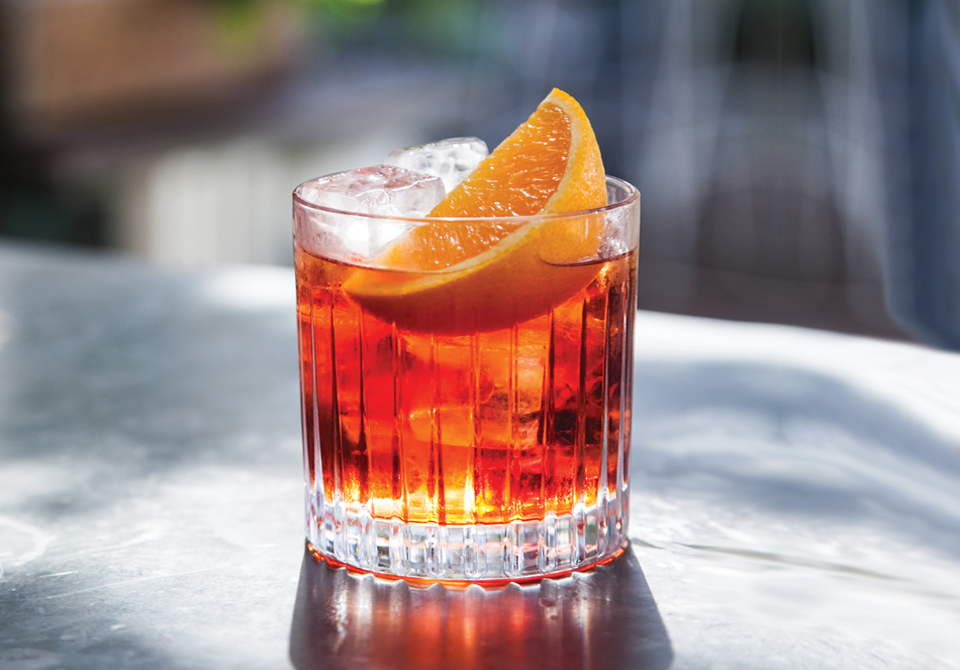In 1919, Count Camillo Negroni walked into a bar in Florence and asked bartender Fosco Scarselli to mix him his usual drink, but with a twist. Inspired by travels through North America and time spent in London — and potential weariness after a long day — the Count ordered an Americano. Instead of the usual soda, he wanted a dash of gin to accompany the Campari and vermouth.
Matteo Downtown’s bar manager Maurizio Furiani says the story is well-known and widely accepted. Of course, there’s a longer history behind the classic Negroni. On the timeline of cocktails, it sits somewhere in the middle and its fame has oscillated over the decades. But the reason for its popularity among Furiani’s contemporaries elucidates the mechanics of the modern bar industry.
At Moya’s Juniper Lounge in Redfern, Sydney, Negronis make up a considerable percentage of sales, despite being purposely left off the cocktail list upon opening. “About 2006, maybe 2004, it started showing up as a real hospo drink,” says owner Charles Casben. “At the time, it was left of centre enough mainstream folk didn’t know what it was. It indicated, ‘Hey, I’m hospo’.”
After emerging as an industry libation, the Negroni eventually re-entered the common conscience buoyed by its simplicity, the ease with which it fits into modern cocktail lists and some master marketing. According to Casben and Furiani, it’s currently one of the most consumed cocktails in the world, only coming in behind the martini.
“The simplicity makes it available everywhere and generally consistent, so people feel confident ordering it,” says Casben. “Something that shouldn’t be neglected is that there is a body in the world that stands to profit from it; one of the ingredients is a branded product that’s unique, bordering on irreplaceable, [and] Campari has a long history of promoting it.”
One such promotion is Negroni Week. “It opened the door for everyone to know what the Negroni is about and how to twist it,” says Furiani.
Before rules are broken, they need to be mastered. While the Negroni is a simple drink, its elegance isn’t assured. In fact, when Count Negroni was imbibing, it was most likely a different experience.
“Drinks that were pretty rough have become more refined and approachable for everyone,” says Furiani. “The Negroni is a combination of three things: sweetness, bitterness and a kick. It’s the holy trinity.”
The sweetness and bitterness come from the rosso vermouth and Campari respectively, while the gin delivers a kick. The simplicity is obvious — three ingredients combined in even quantities.
What modern mixology has brought to the bar are techniques that help the components meld together more harmoniously. “The first time I had one it was served up,” says Casben. “But 12 years later we’re back on ice with a twist of orange. I think it’s better on ice and I think it’s better to dilute. It’s bitter as hell and so sweet — the more dilution, the better.”
Furiani agrees. “We used to just pour over ice, so you could really feel the kick,” he says. “There was way less harmony than what we’re drinking in Australia now. It has because we stir over ice and strain to allow dilution and balance the flavours together.”
Bartenders may be doing their utmost to create a softer Negroni, but the kick is still key and many variations achieve their twist by way of it. Furiani says gin is the catalyst for the kick, but there are other ways to achieve a similar result.
“You can have a beautiful Negroni with tequila, rum or even bourbon,” he says. Matteo Downtown has five versions in its Negroni family: the classic Downtown Negroni sits alongside the Negroni al caffe, the golden sbagliato, the il conte bianco and the Negroni invecchiato. The most popular is the Negroni invecchiato, a riff on both the Negroni and the Boulvadier, a cocktail similar to a Negroni but with an entirely different origin story.
“I don’t want to just replicate a recipe,” says Furiani. “I follow the specs — sweet, bitter, kick. There is no Campari or gin — it’s whisky, vermouth and an amaro aged in a wooden bottle made especially for ageing cocktails.”
Some variations, like the Negroni al caffe, stray less from tradition, combining the original three ingredients with a single origin espresso, but the lines have become increasingly blurred as Campari alternatives enter the market.
Casben is pleased to see one of Moya’s variations, which uses local ingredients, hitting the mark with guests. “It has a Campari substitute; Okar amaro, which is quite similar in style to Campari. Visually, it’s almost identical and although the taste profile is a little different, you would need to be reasonably experienced to pick it out,” he says.
“I’m a bit of stickler for tradition so I would say it’s a Negroni if it’s the original recipe. [But] once a drink becomes recognisable, it becomes about what’s going to sell a drink — if adding Negroni to the name helps move it, you’re going to do it.”
However, if bartenders are taking such liberties with their twists, how will the integrity of the Negroni be maintained? “With all drinks, your customers will judge you more harshly than anyone else, so listen to them,” says Casben. “If you make a couple of variations and one is hitting the mark, go with it. If it isn’t, chop it.”
Furiani follows the same formula, and says it’s always about elegance of taste and tailoring drinks to suit customers. “I need to understand who my customer is and what they love to drink.”
When Scarselli mixed the first Negroni for the Count, he did just that and bartenders shouldn’t be afraid to do the same — the result might just be the next classic.
This story originally appeared in Hospitality‘s February issue. Subscribe here.

